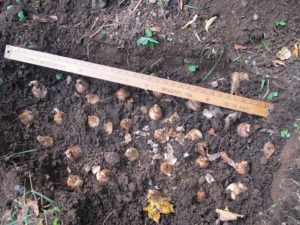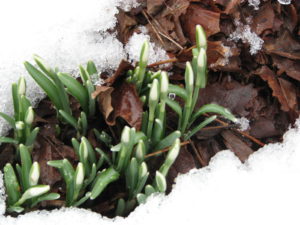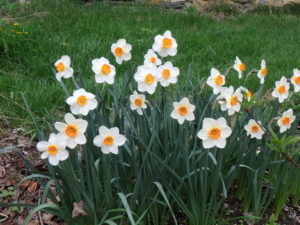When – and How – To Plant Bulbs for Spring Blossoms
When the soil drops to 60 degrees Fahrenheit at proper planting depth, you can plant bulbs. You’ll need a soil thermometer, but that’s a handy device anyway – they’re useful in the spring to see if the soil is warm enough to plant tomatoes or eggplants without making them recoil in shock like a sixth grader wading into a chilly pond.
Soil thermometers are similar to the probes sold for testing turkey temperatures in the oven. A steel probe with a dial on top. You just poke it into the soil and wait a moment. Sometimes I put a pieces of tape at different locations: 3 inches for crocus, 6 inches for daffodils, 8 inches for tulips. Then I can easily see the temperature without digging. They are available at garden centers, or on-line.
Why sixty degrees? In soil warmer than that, your bulbs may sprout, thinking it’s spring. That’s not lethal, but not desirable. You do want the soil warm enough so that the bulbs will establish roots now, getting them ready for action in spring and holding them in place against frost heaves.
I tested the soil in a few places recently to see if it’s ready to plant. In full sun in my vegetable garden, the soil was slightly above 60 degrees, but in a shady flower bed the soil was in the high fifties. And down 8 inches it was 4 or 5 degrees cooler. I’ll plant crocus later, as the soil at crocus depth (3 inches) is warmer than deep down.
I bought my house 47 years ago, and I’ve been planting bulbs most years ever since. Most places suitable for bulbs, have bulbs. So this year I shall plant some in the lawn. Not daffodils, as the foliage can’t be cut back until July, and that would keep the lawn looking unkempt. But I could plant small bulbs like crocus, snowdrops or scilla. Their foliage dies back early enough that I’ll be able to mow the lawn when needed without compromising the bulbs. I’ll plant them by poking holes in the lawn with my CobraHead weeder (www.CobraHead.com).
Some years ago I was visiting a garden in Wales. The gardener had a bucket of tennis balls, and was tossing them onto the lawn. “What in the world are you doing,” I asked. He explained that he wanted to plant bulbs in a random pattern. Wherever a ball landed, he planted a bulb. Maybe I’ll try that.
I like to consider tulips as annuals. They do come back in year two at about 50 percent of year one, and year 3 is usually about 50 percent of that. So in general I buy 100 tulips, plant them all in the vegetable garden, and enjoy a big burst of color. I cut most and use in the house, or as gifts. I plant right over them after blooming, not worrying at all if they survive. A few will pop up in the lettuce the following year.
Daffodils are not attractive to rodents or deer as bulbs or as flowers. In fact, they are vaguely poisonous. But tulips are tasty to critters. Last year I planted a few cloves of garlic in with my tulips to repel rodents. I don’t generally have trouble with deer – I have a ferocious corgi who scares them off. They think she is a wolf, I suppose.
If you have deer problems, you probably will want to plant tulips in big swaths and then surround them with a temporary fence before they bloom. Even a 4-foot chicken wire fence should deter them, I think. There are repellents, of course, but I’ve never used any with tulips.
I have 3 books in my personal library about bulbs. All say to plant tulips and daffies 6 inches apart. I don’t. It uses too much space. I plant them three inches apart, and they do fine.
There are two keys to success when planting most spring-blooming bulbs: First, plant in full sun. Yes, in principle, you can plant daffodils in the woods if there are no evergreens and they will get enough energy from the sun before the maples leaf out. But they will do better in a sunny border. Root competition from trees diminishes their vigor.
Second, plant bulbs in soil with good drainage. Soggy soil is a death knell to most bulbs. If you have a heavy clay soil that holds water, plant your bulbs on a slope. Toss away half the soil you dig out and mix a light, fluffy compost with the other half. Dig deeper than needed, and fill with that same fluffy mix.
I don’t regret a penny I’ve spent on bulbs. Yes, some can be expensive. Yes, some don’t perform well. But by the end of a long New England winter I am so ready for blossoms I am willing to do almost anything (short of a deal with the devil) to get flowers blooming outdoors.
So go buy bulbs now. Later, when it’s time to plant, the best ones will be sold out. Start at your local garden center and look on-line for a few fancy things. Do this every year, and you’ll be delighted!
Is it okay to prune shrubs now? Learn which ones can be pruned by reading Henry’s blog post at https://dailyuv.com/news/





